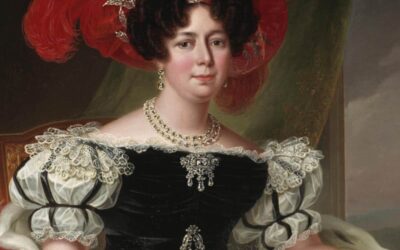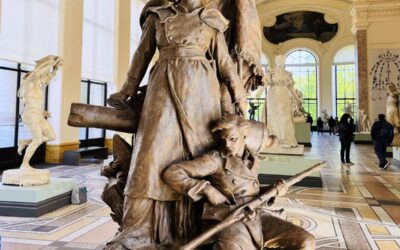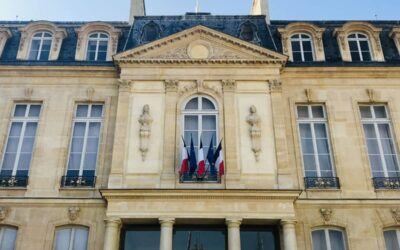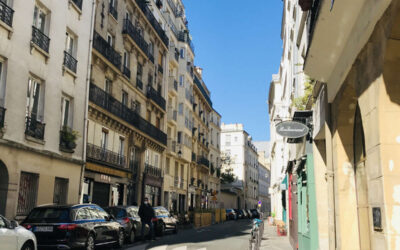If you have ever seen Instagram photos of Paris, you have probably seen photos of the striped columns in Palais-Royal. In a city full of monuments, this sumptuously decorated palace beckons tourists from all over the world. Which is quite interesting when you consider that you can only visit the courtyards and not inside the actual building.
Located in the 1st arrondissement of Paris, the Palais-Royal is today a series of government offices. It consists of several buildings which are interconnected, with a foreground courtyard, and a larger garden courtyard all within the premises.
It is today the office of the Minister of Culture, the Conseil d’Etat (State consul) and Conseil Constitutionnel (Constitutional consul). Not to mention, a series of high-end apartments allocated to government officials.
Over the centuries, it has been a place that has had a front seat to state power and the country’s history. And along with all that history, many names. From Palais-Cardinal, Palais-Égalité, Cirque du Palais, Palais-National and Palais du Tribunat, it has gone through many iterations.
So let’s explore the history of Palais Royal and cover some interesting facts about the place, shall we? Allons-y!
- 1. Construction as Palais Cardinal
- 2. Axe Historique de Paris
- 3. A Royal Palace
- 4. Cirque du Palais Royal
- 5. French Revolution
- 7. Palais de l'Égalité
- 6. A commercial center
- 8. Royal Restoration
- 9. Colonnes des Buren Art Installation
- 10. Office of the Minister of Culture
- 11. Conseil Constitutionnel
- 11. Conseil d'État
- 12. Comédie Française
- 13. Public Gardens
1. Construction as Palais Cardinal
The original Palace on this site was not for a King but for the powerful Cardinal Richelieu, who was an advisor and First Minister to Louis XIII in the 17th century. (Yes, the villain in the Three Muskateers novel by writer Alexandre Dumas was based on a real life character.)
Richelieu bought the Hôtel de Rambouillet in 1624, which for him had the advantage of being close to the Louvre Palace where the King lived.

With his architect Jacques Lemercier, he would begin the expansion and transformation of the hotel into a regal palace with sumptuous apartments. Along with a theater, it would become one of the most beautiful in Paris.
2. Axe Historique de Paris
The Palais Royal was not only near the Louvre museum, but in the center of the city, very close to some of the most famous sights in Paris.
It is in a direct line from Rue de Rivoli to the Place de la Bastille on the east, where the French Revolution started with the storming of the Bastille, at a distance of about 1.5 miles (2.5km).
In addition, on the west if you continue in a straight line on Rue de Rivoli for 1 mile (1.5km), you arrive at Place de la Concorde, which is where King Louis XVI and Marie-Antoinette were guillotined.
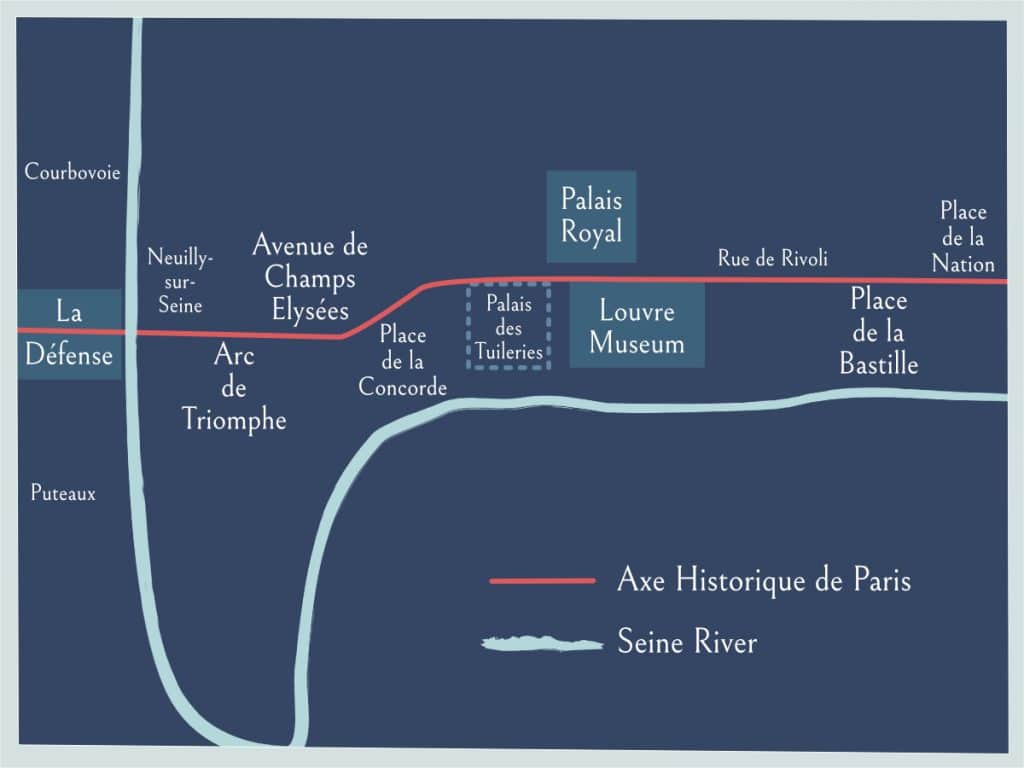
And if you go straight past Place de la Concorde (with a few meters deviation, you will be on the Axe historique of Paris towards the Champs Elysées, Arc de Triomphe, and La Défense. You can read more about the history of Paris here.
3. A Royal Palace
As a Catholic Cardinal, Richelieu was not allowed to marry or have children. As such, he gave his palace to the king, by deed of donation upon his death in 1642.
The deed of donation stipulated that the hotel would remain forever inalienable to the crown, to serve as accommodation for the king or the heir to the crown.

It would become the home of 5-year-old Sun King Louis XIV who ascended to the throne upon the death of his father Louis XIII in 1643. His mother Anne of Austria, who was regent, believed that it would be a more accommodating home for children, than the over-grand Palais du Louvre.
However, it was a tumultuous time known as the Fronde, with nobles at the time contesting Anne. At one point, the 12-year old Louis and his mother were held prisoner at Palais Royal until they conceded to the demands of the frondeurs.
This made Louis detest and distrust Paris. At 21, in 1661 young Louis reached his majority, and started to make a few decisions. Instead of the Louvre which was still a royal palace at the time, he immediately looked for a new power base. He settled on the family’s old hunting lodge: Versailles.
It would be the Château de Versailles that would become the center of the royal court life, with the Palais Royal becoming another royal palace among many.
4. Cirque du Palais Royal
In 1780, the Palais Royal was sold to the Duke of Chartres (future Duc d’Orléans) Philippe d’Orléans who was a cousin of the King.
He would embark on a large real estate project to subdivide around the perimeter of the garden, to rent the ground floors to traders and to make the Palais-Royal the center of attraction for all of Paris.
The new buildings would open onto several new streets dedicated to the Duke’s boys, rue de Montpensier to the west of the garden, rue de Beaujolais to the north and rue de Valois to the east.

In the center of the gardens would be the Cirque du Palais-Royal to organize horse races. With boutiques underground and all around, this would be one of the first shopping malls of its kind in the world.
It was more than just a mall however, gambling halls were installed and ladies of night flocked, attracted by the money.
5. French Revolution
On July 14, 1789, the prison at Bastille, which is just 2 miles (3.5km) away from Palais Royal, would be stormed by the Revolutionaries, and France would never be the same again.
Unlike some of the other buildings owned by the nobility, the Palais Royal was not ransacked and remained remarkably intact.
7. Palais de l’Égalité
After the fall of the monarchy, the Duke of Orleans took the name of Philippe Égalité. The Palais-Royal in turn became the Palais de l’Égalité, to show that he supported the revolutionaries.
He had always disliked the King and Marie-Antoinette and as the Premier Prince du Sang, he was the most important personage of the kingdom after the king’s immediate family. Therefore, he would be next in line to the throne should the main Bourbon line die out (or guillotined).
Although the Duke was popular with some Parisiens for his “pleasure palace”, he was still suspect to the revolutionaries.
This tightrope of diplomacy would not last long however. On April 2, 1793, the Duke of Orleans was arrested in his apartments and would be imprisoned at the Conciergerie and executed. The Palais Royal would no longer be private property, and was once again reunited with the French State.
The Duke of Orleans descendants however did not die out, and continue to be claimants to the French throne.
6. A commercial center
After the revolution, gambling and other questionable activities at the Palais de l’Égalité continued in full force.
It was from one of the shops of the Palais Royal that female activist Charlotte Corday would buy a knife to murder one of the leading figures of the revolution, Jean-Paul Marat.
“Life, death, rapid, coarse, violent pleasure, exterminating pleasure: this is the Palais-Royal de 1793.
French historian Jules Michelet
The infamous Marquis de Sade would also refer to the palace in his book Philosophy in the Bedroom (1795).
The Palais-Égalité was a center of opposition to the government, where speakers would gather to rile up the crowds against the government.
Without much consensus of what to do to this prime real estate in the center of Paris, the governement of the day decided to sell much of the furniture, and rent the palace out.
The interior of much of the residential portion of the Palais Royal are altered by the tenants and divided into apartments. The Cirque du Palais Royal would burn down on December 15, 1798, and would not be rebuilt.
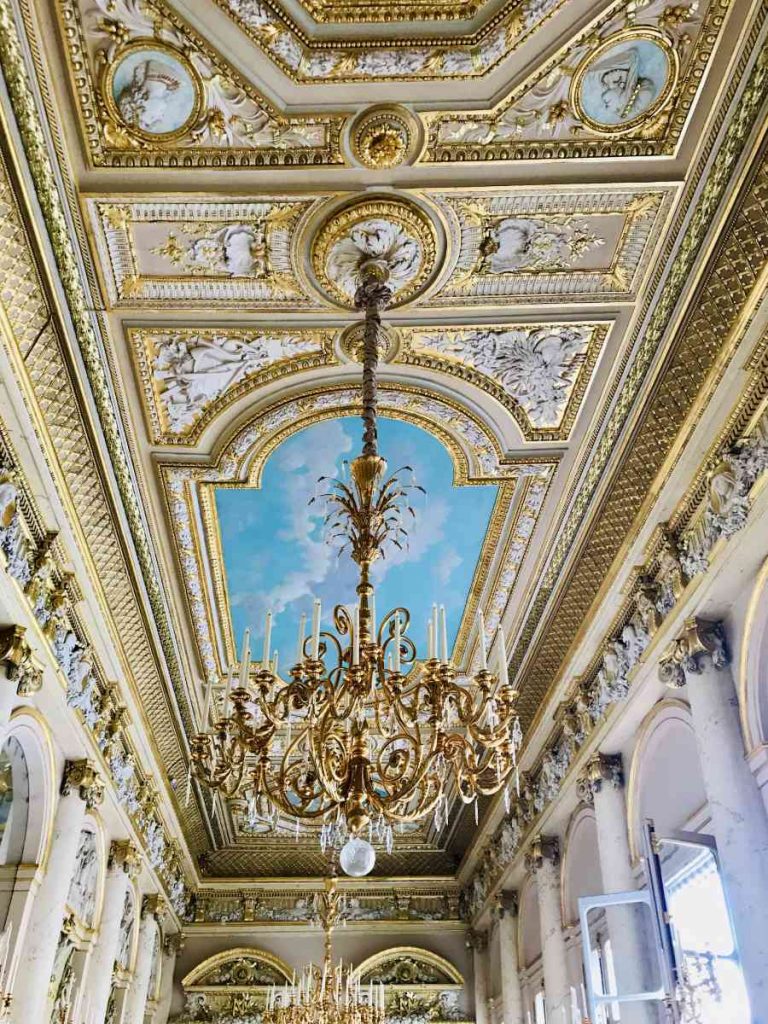
8. Royal Restoration
After Napoleon Bonaparte took power, he installed the Tribunate (a government council) in the palace, now called the Palais du Tribunat. The stock exchange also briefly moved in until 1816.
When the Bourbon monarchy was restored, the Palace was returned Orléans family who would make attempts to restore and renovate it.
The shops, gambling halls, and courtesans remained however on the ground levels and its reputation as a place of leisure continued.
Another revolution in 1848 would spell an end to that however. King Louis-Philippe was overthrown, Palais Royal was looted, the paintings burned or lacerated, the furniture and works of art thrown from the windows. Once again placed in the domain of the State, it becomes the Palais-National.
It would nearly burn down again in 1871 during the Paris Commune riots. However its survival, and given the damage to other government buildings like Palais d’Orsay, meant that it would soon start to house government agencies and ministries, rather than shops and boutiques.
9. Colonnes des Buren Art Installation
But it would be in the 1980s that the Palais Royal would once again become the center of attention.

This famous art installation in the famous cour d’honneur (forecourt) is what puts the Palais Royal on ever tourists’ bucket list to Paris. It was controversial when it was installed in the 1980s, but today it is one of the most famous art installations in the world.
It was installed in 1986 by Daniel Buren and was called “Les Deux Plateaux”, but is now more commonly known as the Colonnes des Buren. Entrance is free.
10. Office of the Minister of Culture
These days, at one end of the Palais Royal you have the offices of the Minister of Culture. For some context, the Colonnes de Buren were installed upon request of the former Minister of Culture, Jack Lang.
Now, you cannot actually go in to visit the Ministry of Culture, as a tourist. It is only open one weekend of the year, and that is for Journée du Patrimoine in mid-September, along with other government buildings like the Palais de l’Elysées and Assemblée Nationale.
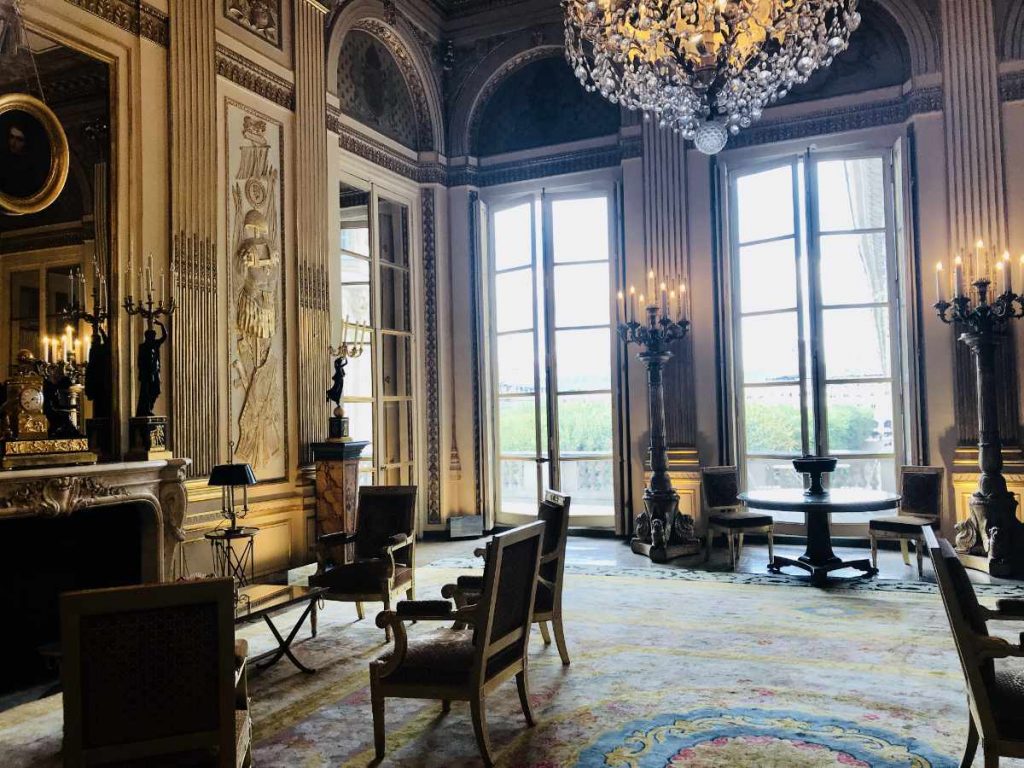
It is a small set of offices, with a waiting room, a large salon called the Salon Jérôme to greet guests and dignitaries, and the Minister’s office. Additional offices for the Ministry of Culture are in less haute (highbrow) office buildings.
11. Conseil Constitutionnel
In another corner of the Palais Royal today is the the Constitutional Council. It is a French institution created in 1958 which decides on the conformity with the Constitution of the laws and certain regulations referred to it.
Its nine members are often nicknamed by the media “les Sages” and serve a single mandate of 9 years each. They are appointed in threes, 3 by the French President, 3 by the President of the Assemblée nationale, and 3 by the President of the Sénat.
Former Presidents and Prime Ministers of France are often appointed to the Conseil Constitutionnel.

The job of the Conseil Constitutionnel is to ensure the regularity of national elections and referendums. It can also intervene in certain circumstances of parliamentary and public life, in cases of question of constitutionality.
11. Conseil d’État
Next to the Conseil Constitutionnel is the Conseil d’État of France. The Conseil d’État (meaning “Council of State”) is a governmental body that is both a legal adviser of the executive branch (i.e. the President of France) and as the highest Supreme Court for administrative justice.
It was established in 1799 by Napoleon Bonaparte as a successor to the King’s Council (Conseil du Roi), after the fall of the monarchy during the French Revolution. It is a legal body, made up of the country’s top judges and legal officers.

Along with several offices, the Palais Royal contains the Salle du Contentieux (meaning “Hall where contentious hearings are held”).
It can be approached by French citizens, associations, and companies to contest decisions made by government agencies, mayors’ offices, etc.
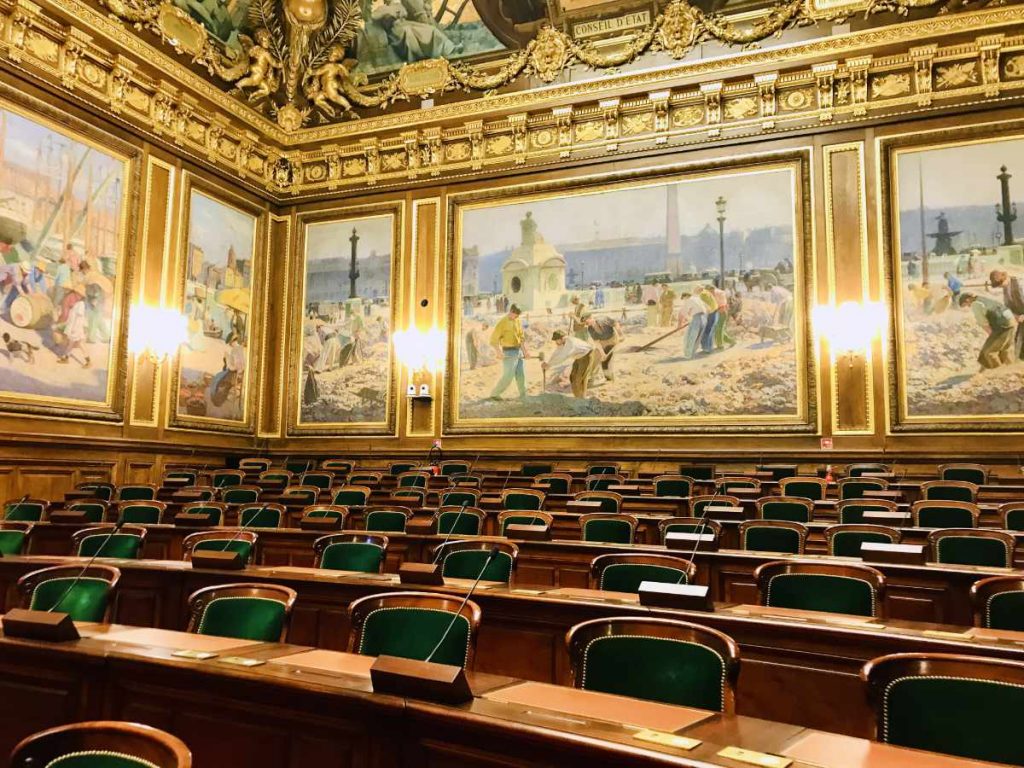
In addition, there is the Assemblée Générale in the Conseil d’Etat where laws proposed by government ministers and senators are examined before being debated and voted on by the Assemblée Nationale and the Senat.
12. Comédie Française
Along the side of the Palais Royal is the Comédie Française which is a large theatre hall.
It was Cardinal Richelieu who built the original opera hall in his palace, which unfortunately suffered much damage during a couple of fires. It would be at this theatre that the famed troupe of Molière would perform, (at which time it had become known as the Théâtre du Palais-Royal).
Since then it has undergone several renovations and today seats around 1000 spectators and holds over 900 shows in an average year.
13. Public Gardens
Behind the main inner courtyard (where the Buren art installation is maintained) is a large garden which is surrounded by two long galleries on either side.
Walking along, the Galerie Montpensier and Galerie de Valois are lined with small shops and boutiques that harken back to the days when the Palais Royal was a commercial center.

Compared to the nearby Jardin des Tuilieries however, this formal garden à la française is much less frequented and is a quiet haven in the middle of the city. Entry to the gardens is free.

If you enjoyed this article, you may enjoy reading more facts about Paris. A bientôt!

